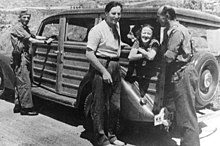|
Gerda Grepp
Gerda Johanne Helland Grepp[1][2] (26 May 1907 – 29 August 1940) was a Norwegian translator, journalist, and socialist.[3] She was the daughter of former chairman of the Norwegian Labour Party Kyrre Grepp and journalist Rachel Grepp.[4][5] She was married to Italian-Swiss potter Mario Mascarin (1901–66). They had a son Olav Kyrre (Ping) Grepp and a daughter, Solveig Marie Alexandra "Sacha" Grepp. The daughter was named after family friend Alexandra Kollontai.[6] Spanish Civil WarGrepp covered the Spanish Civil War as a reporter for the Labour Party newspaper Arbeiderbladet from 1936. She arrived in Barcelona in October 1936, as the first female reporter from Scandinavia.[4] She travelled to Madrid, where she experienced bombing attacks on the city. With Ludwig Renn she drove to the Toledo front.[4] During her travels, she was also accompanied by her friend André Malraux.[7] While in Spain, Grepp served as an interpreter for other Norwegians.[7] Both Grepp and the other Norwegian correspondents in Spain, like Nordahl Grieg and Nini Gleditsch, sympathized with the Republican cause in the war.[7] Gleditsch and Grepp helped organize a large-scale aid effort for Spain, based around the Norwegian labour movement.[8] According to professor Rune Ottosen, Grepp and Birgit Nissen were marked with "sharp pens against the growing fascism".[9] In January and February 1937 she visited Málaga, together with Hungarian journalist and reporter for the British daily newspaper News Chronicle, Arthur Koestler.[5][10] She and Koestler took shelter with the eccentric 72-year-old Sir Peter Chalmers Mitchell, who had stayed on in Málaga "to protect his house and servants" while his compatriots fled to Gibraltar.[11] During the battle of Málaga she barely escaped the attacking Nationalist forces.[12] Grepp left Málaga on 6 February, while Koestler was still in the city. On 7 February Italian troops occupied the city. Koestler was arrested, sentenced to death as a spy, and placed in a death cell in Sevilla. However, after considerable international pressure, he was released from custody. This episode is recorded in detail in Sir Peter's memoir, recently republished by The Clapton Press.[10] From May 1937 Grepp spent several weeks in the Basque Country. She visited the Republican Basque Army defensive line called the Iron Belt, and experienced the Battle of Bilbao.[13] Grepp frequently found herself in dangerous situations while in Spain.[12] During her time in Spain Grepp was suffering from tuberculosis. Eventually she was compelled by her ill health to leave the war zone and return to Norway.[7] Death and legacyGerda Grepp died of tuberculosis in German-occupied Norway on 29 August 1940, 33 years old.[7][14] She was buried in Vestre gravlund in Oslo.[1] Grepp's work has since been largely forgotten, her fellow journalist Lise Lindbæk instead being commonly seen as Norway's first female war correspondent.[12] A biography of Grepp, written by Elisabeth Vislie, was published in 2016.[15] References
Further reading |
||||||||||||||||
